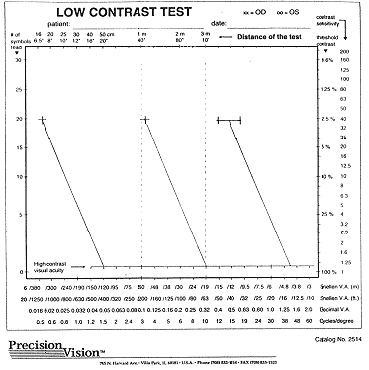Discussion:
The ICIDH does not include paediatric assessments. Therefore the following text has been
written for discussion:
Assessment of the functions requires a person who knows the different techniques of
communication and is familiar with the function of deaf-blind persons. Wrong interpretations
of abilities are common when the tester does not understand the communication and life
experiences of a deaf-blind person. In a number of cases deaf-blind persons have been
classified as having intellectual disability when there was poor communication during testing.
CHAPTER ONE D - VISION IN INFANTS AND CHILDREN (000-000)
In the assessment of infants and children, developmental aspects of the use of vision create the framework. Vision plays a central role in the development of eye contact and bonding (emotional attachment), early communication, motor development, development of spatial concepts, object permanence, balance, picture perception and language. Impaired vision affects also incidental learning and causes problems in visual communication in groups of children, particularly in the groups of toddlers and teenagers. Assessment of the consequences of impaired vision in infants and children covers all the developmental areas. Need for early intervention and special education is specified in each functional area.
In each functional area, the activities coded in this chapter represent a manifestation or impact of visual impairments in the activity. The accomplishment of activities is coded in their own right without reference to the nature of the underlying impairment. Since half of visually impaired infants and children have other impairments that affect their activities, the role of other impairments in the use of vision should be recorded as well.
In each developmental area three different qualities can be recorded:
-
the role of vision in the development of the activity is
- normal or near normal
- is not normal but is useful in the development of the activity, supporting therapies are needed,
- vision is not sufficient to support the development of the activity, the activity needs to be learned through techniques typical to blind infants/children.
- The areas of development to be covered are:
- eye contact
- bonding (emotional attachment)
- early communication
- motor development
- development of spatial concepts
- object permanence
- balance
- picture perception
- language
- incidental learning
- visual communication in groups of children
- bonding (emotional attachment)
Additional areas of development may be documented when found important.
Contrast sensitivity in different low vision conditions:

The visual acuity values at 2.5% contrast level are derived from the above picture. In it, at the high contrast level, are marked the present visual acuity values for severe low vision at 20/400 (0.05, 6/120) and for low vision 20/63 (0.32, 6/19). The declination of the slope is that of normally sighted individuals. Among persons who have visual acuity 20/16 (1.25, 6/4.8) and who see a few symbols on the next line, variation of visual acuity values at 2.5% is between 20/50 (0.4, 6/15) to 20/32 (0.63, 6/9.5). I have chosen the mean between these two values to be the point of the upper part of the descending slope. Among people who have low vision, the variation at low contrast is much greater. The point that we get by using the curve of the normally sighted individuals might be as fair as are our present values at high contrast.